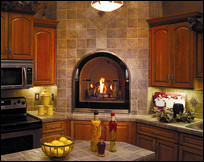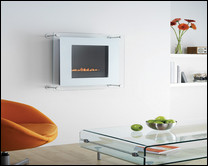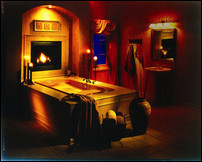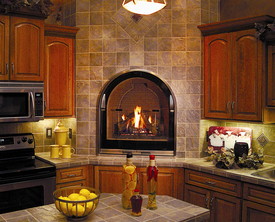 A counter-height fireplace makes a cozy, inviting focal point for the kitchen. Photo courtesy of Fireside Hearth & Home. |
Fireplaces have been an integral part of homes for generations. Today’s fireplaces are cleaner and more energy-efficient than ever and give homeowners a range of options that would have been impossible even a few years ago. Who would have thought that you could hang a fireplace like a picture frame or a flat-screen TV?
That technology—including sleek, wall-hung gas fireplaces that extend mere inches from the wall and don’t require a chimney—is available now. One option is a direct-vent fireplace, which vents either through the exterior wall or through the roof. Another is a catalytic vent-free fireplace, which doesn’t require venting at all. It cleans hot air as it leaves the combustion chamber, eliminating carbon monoxide and reducing other emissions.
 Vent-free fireplaces like this one don’t require building a chimney or venting through an exterior wall or the roof, which means they can be hung on any wall. The Elite Catalytic Vent-Free Gas Fireplace is shown here. Photo courtesy of Lennox Hearth Products. |
“No longer is there the expense to the builder and homeowner of framing, drywalling and marble mantels,” says Don Kaufman, manager of sales training for Orange, Calif.-based Lennox Hearth Products.
Freed from the need for chimneys, small fireplaces are now popular additions in kitchens, breakfast rooms, master bedrooms and master bath suites. They’re also being added to home theaters and pool houses, says Jeff Zaas, manager of Wilshire Fireplace Shops in Los Angeles.
“A fireplace adds warmth to any space since it has life and, of course, adds the romance wanted in many situations,” Zaas says.
Fire Art
Fireplace finishes and shapes have expanded as well. Natural stone, brick, tile and wood—all traditional, widely used materials for fireplace mantels and surrounds—have been joined by such contemporary finishes as steel, enamel
 Fireplaces can add warmth, style and mood wherever it’s desired in the home. They have become an increasingly popular feature in master bath suites. The Heatilator Novus is shown in this image. Photo courtesy of Fireside Hearth & Home. |
and glass. The Hearth, Patio and Barbecue Association based in Arlington, Va., reports that along with the familiar square box design, European contemporary design—a sleek, linear look—is gaining popularity, as well as round tubes.
Free of the need for a floor-level hearth, the units are “more like fire art than a traditional fireplace,” says Joel Ginsberg, division manager for Roseville, Minn.-based Fireside Hearth and Home, maker of Heat & Glo and Heatilator fireplaces. “Mounted on the wall, it’s true fire and true heat, but it’s three to four feet off the floor. It’s probably at the height you’d put a main piece of art in a room.”
Lower Heating Costs, Environmental Impact
While fireplaces remain primarily an aesthetic feature in homes rather than as a primary source for heat, energy efficiency is playing a key role in fireplace innovation as homeowners work to reduce their heating bills and their impact on the environment. Ginsberg says it’s not unusual for new houses to have four or five fireplaces as “zone heaters” that allow the homeowner to turn down the thermostat.
“This is how northern Europeans heat their homes,” Ginsberg says. “They think we’re silly for using central heat.”
 |
||||
|
||||
Los Angeles-based builder Janna Levenstein has fallen in love the Australian EcoSmart fireplace, a fireplace that burns denatured alcohol, a renewable fuel source, and can be built into any space.
“Anyone can have a fireplace now,” she says. “Someone who is renting an apartment could have a fireplace and take it with them when they leave.”
Levenstein has one in her own home and uses it all the time, she says. She likes that it’s very low maintenance—“you just like the thing like a candle,” she says—and that she’s not putting smoke into the air. The difference from a fire from wood logs, she says, is in the feel. “It doesn’t feel like a roaring yummy fire,” she says. “It’s more slick and hip, and it burns a blue flame rather than yellow.”
For homeowners who equate a fireplace with the cheery crackle of burning wood and smoke rising from the chimney instead of flipping a switch or opening a valve, Kaufman notes that the fireplace industry has transitioned over the last several years from wood to gas products.
One major reason for that switch is pollution control. Many large metropolitan areas are out of compliance with federal regulations for air quality. According to the Environmental Protection Agency, wood smoke can account for up to 80 percent of the particulate matter emissions in residential areas during typical wood-heating seasons. As a result, some municipalities ban the use of fireplaces on days when the air quality is poor.
There’s a benefit to homeowners, though, Kaufman says. Research at Lennox found that people with open-front, wood-burning fireplaces only use them about a dozen times a year. Owners with gas fireplaces use them as much as 160 times a year. “It goes from the peripheral to the center of the home almost every night,” he says.
Credit: Renovate Your World




























